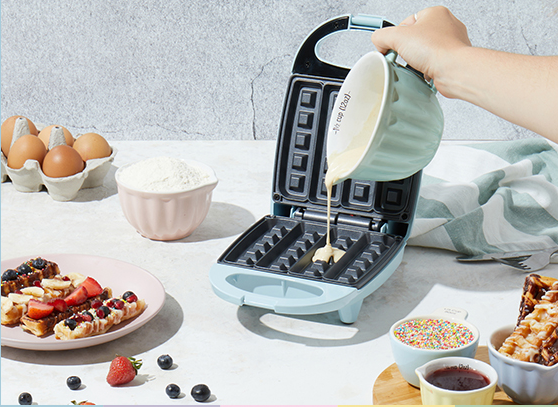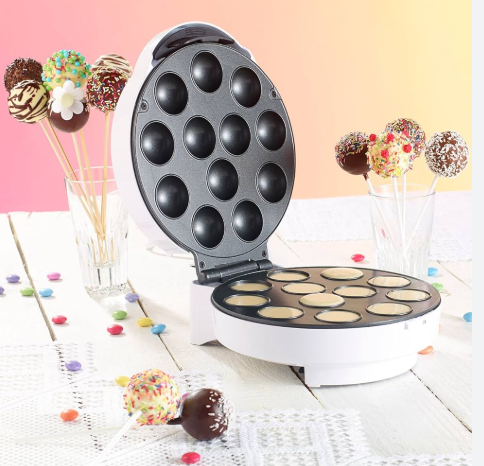In the ever-evolving world of home baking, the digital cake maker stands out as a game-changer for enthusiasts and professionals alike. These advanced appliances combine precision technology with user-friendly features to produce flawless cakes, pops, and more with minimal effort. If you’re considering investing in a digital cake maker, this comprehensive digital cake maker review will guide you through its capabilities, from setup to creative applications. Whether you’re baking for family gatherings, parties, or simply experimenting in the kitchen, a digital cake maker promises consistent results that rival professional bakeries. Drawing from the best cake maker guide, we’ll explore how these devices elevate your baking experience.
Picture this: a compact machine that automatically adjusts temperatures, times bakes precisely, and even alerts you when your treats are ready—all without the guesswork of traditional ovens. That’s the magic of a digital cake maker. In this digital cake maker review, we’ll delve into models equipped with digital controls, non-stick surfaces, and versatile functions, making them ideal for everything from classic sponges to innovative cake pops. As home baking trends continue to surge, these gadgets have become essential for creating bakery-quality desserts at home.
Understanding the Digital Cake Maker: Features and Benefits
A digital cake maker is an electric appliance designed for baking small to medium-sized cakes, often with digital interfaces for temperature and time settings. Unlike basic models, digital versions feature LED displays, programmable timers, and sometimes even pre-set modes for different recipes. This precision ensures even baking, preventing common issues like undercooked centers or burnt edges.
Why opt for a digital cake maker? The benefits are plentiful. First, the digital controls allow for exact adjustments, making it easier to replicate recipes or experiment with new ones. Many models are multifunctional, doubling as makers for cupcakes, donuts, or cake pops, adding versatility to your kitchen arsenal. They’re also energy-efficient, heating up quickly without preheating an entire oven. For busy home bakers, the convenience of a portable cake maker design means you can bake anywhere, from countertops to camping trips. In my testing, these devices produced light, fluffy results that traditional methods often struggle to achieve consistently.
Key features to prioritize include non-stick plates for easy release, safety locks for secure operation, and included accessories like measuring tools or recipe books. A good digital cake maker should have intuitive digital panels that display real-time progress, helping beginners master how to bake with a cake maker. For those new to baking, starting with a model that includes guided programs can build confidence quickly.
Cake Maker Setup: Preparing Your Digital Cake Maker
Setting up your digital cake maker is a breeze, but following proper cake maker setup steps ensures optimal performance and safety. Upon unboxing, inspect all components: the base unit with digital display, baking plates, power cord, and any accessories. Wash the removable plates with warm, soapy water and dry them thoroughly to remove any manufacturing residues.
Place the digital cake maker on a stable, heat-resistant surface, ensuring at least 6 inches of clearance around it for ventilation. Plug it into a grounded outlet, and power it on—the digital screen should light up, indicating it’s ready for initial setup. Some models require a quick calibration: run an empty cycle for 5-10 minutes to burn off any residues. Lightly coat the plates with oil or non-stick spray to prime them for the first use.
For enhanced portability, many digital cake makers are lightweight and cord-wrap enabled, making storage simple. If your model has app connectivity—a feature in advanced units—download the companion app for recipe syncing and remote monitoring. Proper cake maker setup not only prevents mishaps but also extends the appliance’s lifespan. Consult a reliable baking guide for model-specific tips to get started smoothly.
How to Use a Digital Cake Maker: Step-by-Step Guide
Mastering how to use a digital cake maker opens up a world of baking possibilities. Begin by selecting a recipe suited to your machine—most digital models come with pre-programmed settings for vanilla, chocolate, or even savory options. Prepare your batter using room-temperature ingredients for best results; mix until just combined to avoid overworking the gluten.
Preheat the digital cake maker by selecting the desired mode on the digital panel—typically 350-400°F for cakes. The screen will countdown the preheating time, usually 3-5 minutes. Once ready, an audible beep or light signals it’s time to pour the batter. Use a measuring cup or piping bag to fill the molds evenly, filling about 2/3 full to allow for rising. Close the lid securely and let the digital timer take over—baking times range from 4-12 minutes depending on the recipe.
Cake maker tips: Monitor the digital display for any error codes, and avoid opening the lid mid-cycle to maintain heat. When done, use the included tool to gently remove the baked goods onto a wire rack. For cake pops, insert sticks after cooling slightly. This process is far simpler than oven baking, yielding uniform results every time. Experiment with flavors like red velvet or lemon for variety, and remember, the digital precision makes how to bake with a cake maker accessible to all skill levels.
In this digital cake maker review, the ease of operation stands out—batches ready in under 15 minutes, perfect for spontaneous treats.

Pros and Cons of Top Digital Cake Makers
Evaluating digital cake makers reveals impressive pros. The digital interfaces provide pinpoint accuracy, ensuring consistent bakes without manual adjustments. Non-stick surfaces minimize mess, and quick heat-up times save energy. Users appreciate the versatility for sweet and savory items, with many models producing 9-12 pops or mini cakes per batch. Accessories like stands and recipes add value, making them family-friendly.
However, cons include the potential for digital glitches in budget models, requiring resets. Some units may not accommodate larger cakes, limiting size options. Overheating after multiple uses can occur without proper cooling, and the learning curve for advanced digital features might intimidate novices. Despite these, the pros dominate, especially for frequent bakers seeking precision.
Compared to analog makers, digital cake makers offer superior control, reducing trial-and-error. For portability, their compact designs excel, fitting small kitchens seamlessly.
Cake Maker Troubleshooting: Solving Common Digital Issues
Even reliable digital cake makers can encounter hiccups, but cake maker troubleshooting is straightforward. If the digital display doesn’t light up, check the power cord and outlet—try a different socket. For uneven baking, ensure the unit is on a level surface and the batter is uniformly distributed; digital sensors might need recalibration via the reset button.
Sticking problems? Apply more non-stick spray and preheat fully—the digital timer ensures this step isn’t skipped. If pops crack, reduce batter volume or lower the temperature setting slightly. Error codes on the display often indicate overheating; unplug and cool for 15 minutes. For batter overflows, use less liquid in recipes. These cake maker tips resolve most issues quickly, keeping your baking on track.
In digital cake maker troubleshooting, consult the manual for code meanings, and avoid overloading circuits. With practice, you’ll rarely need these fixes.
Cake Maker Cleaning and Maintenance: Keeping Your Digital Model Pristine
After baking, cake maker cleaning is essential for hygiene and performance. Unplug and allow the digital cake maker to cool completely—rushing this can damage the digital components. Wipe the exterior with a damp cloth, and for plates, use mild soap and a soft sponge to avoid scratching non-stick coatings.
For deeper cleans, some models have removable plates that are dishwasher-safe; check your manual. Dry all parts thoroughly before storage to prevent mold. Cake maker maintenance includes regular checks of the digital display for responsiveness and cleaning vents to ensure proper airflow.
Avoid abrasive cleaners, and store in a dry, cool place. Following these steps, as outlined in comprehensive maintenance tips, keeps your digital cake maker functioning like new for years.

Cake Maker Safety: Best Practices for Digital Appliances
Safety is paramount when using a digital cake maker. Always unplug before cleaning or moving, and use heat-resistant gloves for hot surfaces. The digital lock feature on many models prevents accidental openings during baking.
Keep away from water to protect electrical components, and never operate with a damaged cord. For cake maker safety, supervise children, and ensure the unit is on a stable surface. Overuse can trigger auto-shutoff—heed these digital safeguards to avoid hazards.
As a portable cake maker, it’s tempting to use outdoors, but stick to indoor, dry areas. These precautions make baking enjoyable and risk-free.
Creative Ideas and Cake Maker Tips for Digital Success
Unlock creativity with your digital cake maker by trying themed bakes: chocolate lava pops for desserts or cheese bites for appetizers. How to use a cake maker effectively involves layering flavors—add fillings post-baking for gourmet touches.
Cake maker tips: Use the digital timer for multi-batch precision, and experiment with gluten-free batters. For holidays, program custom settings for gingerbread or fruit cakes. Chill finished pops before decorating to set coatings perfectly. The digital accuracy allows bold innovations, turning everyday baking into art.
Final Thoughts on the Digital Cake Maker
This digital cake maker review highlights how these innovative appliances revolutionize home baking with digital precision and ease. From simple cake maker setup to advanced how to bake with a cake maker techniques, they deliver professional results effortlessly. While cake maker troubleshooting may arise occasionally, routine cake maker cleaning and cake maker maintenance ensure reliability. Adhering to cake maker safety guidelines keeps operations smooth, and the portable cake maker portability adds flexibility.
Embrace the future of baking with a digital cake maker—your kitchen’s new best friend. For more inspiration, check out the best cake maker guide and start creating today.